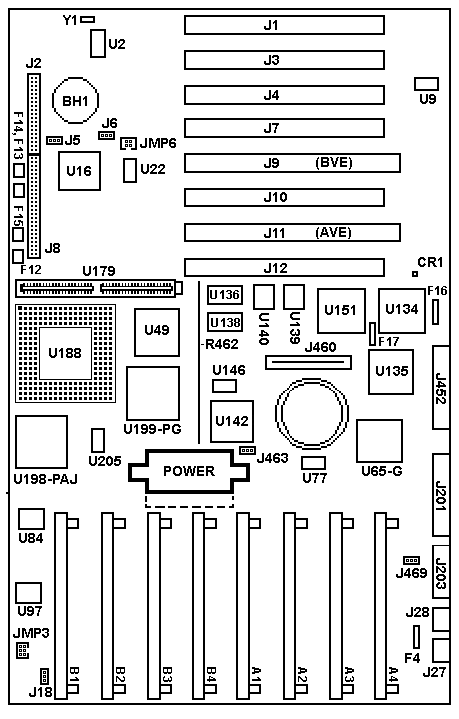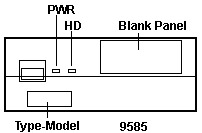9585 K, N Models

BH1 Battery
Holder
CR1 LED
for F/W . Only on during POST.
F4 Keyboard
Fuse Bourn -130 GQ3A
F12, F13, F14, F15
PTC Resistors
F16, F17
SCSI Autoterm? Bourn -205 FN3G
J1, J3, J4, J7, J10, J12 32 bit
MCA Slots
J2 Operator
Panel
J5 JMP1
Password Override
J6 JMP2
Privileged-access password
J8 Floppy
J9 32 Bit Slot (BVE)
J11 32-bit Slot (AVE)
J18 JMP5 Remote Flash 0- Lock,
1- Flash Possibly to allow BIOS Flash over the LAN?
J27 Keyboard
J28 Mouse
J201 Parallel
J203 Serial
J452 External
C68 FW SCSI
J460 Internal
C68 FW SCSI
J463 JMP7 SCSI Boot 0- Allow Allow
RPL?
J469 JMP4
Remote Power On
JMP3 LogicLock
JMP6 ServerGuard
If not installed, jumper two pins by control-panel connector.)
R462 Temperature Sensor?
U2 Dallas DS1585S Serialized RTC
U9 14.3181 MHz Osc "System Oscillator".
It's main function is to provide a known timing base for many computer
accessories, but not the microprocessor or the bus. |
U16 NEC N82077SL
Floppy Controller
U22 24.0000 MHz Osc
U49 10G7808 DMA Controller Used
on T2 and T3 complex.
U65-G 10G4672
U77 22.1184 MHz Osc Clock oscillator
for "Type 3 High-Speed UART". Divided by 2 for better waveform and
1:1 ratio of low and high. 11.0592MHz base clock for the UART.
U84 71G2540
U97 71G2539
U134 61G2444 Internal SCSI Controller
U135 61G2444 External SCSI controller
U136 Sony CXK581001M-70L F/W
U138 Sony CXK581001M-70L
F/W
The -1001 suggests a 128K x 8 bit memory chip. Sony CXK58- family
is SRAM, compatible with Hitachi HM62xxx series (or 61xxx from other mfgs.)
or Fairchilds MB84xxx series.
U139 61G3930, SCSI BIOS, Even F/W
U140 61G3929, SCSI BIOS, Odd F/W
U142 AMD N80C186-20
U146 40.0000 MHz Osc
U151 61G2323 MCA Bus interface
F/W
U179 L2 cache connector Lacuna
Cache
U188 Socket 3 LIF Straight
5v!
U198-PAJ 69G1212
U199-PG 69G1204
U205 66.0000 MHz Osc CPU Clock |
Any Chip IDs?
Please tell ME
if you know the secret identity of one of these chips...
9585-N Ports
9585 N Ports

COM supports up to345K
LPT is standard parallel
SCSI is a Fast/Wide |
9585 Operator Panel

|
Refdisk/Diags
9585rd.exe
(9585 - 486DX-33 / DX2-66) Diagnostics v1.30 23 Feb 94
9585rf.exe
(9585 - 486DX-33 / DX2-66) Reference v1.32 23 Feb 94
F/W
SCSI Adapter Firmware Upgrade 7.1
BIOS Upgrade- I have seen mention
of a flash disk "F5JW15UK" for the K and N models. Can't find it. If you
have a copy, or heard of this file, send me a NOTE
Can I use the Reference v 1.31 on the -xXx?
Another word for the BIOS: Once you'd put the inappropriate
version of the Reference / Diags on an 85 and start for example OS/2 ...
you could see really odd effects. Putting the 1.31 code from the -xNx on
a -xXx result in a "speed cursor": a fast flashing icon on PM and you cannot
click that fast to do anything with the machine anymore with using the
mouse. You need to shutdown the beast over the keyboard. The xxx.BIO files
differ - and these set the onboard timers to false base values. I had that
in '92 or '93 when customers complained about inability to use their machines
after "an update". They used the 1.31 "just because it was there and had
a higher revision number". Without thinking and reading the DOCs as it
seemed.
Power Supply
9585 power supply is 288 watt The 9585 DOES
NOT have a side fan.
Parity / ECC in System Programs
The 85 can emulate ECC using parity SIMMs. This is not worth
it. Leave the Memory Detected setting in Change Configuration to "Parity".
Go to "ECC-P" for more details.
System memory can be optionally expanded up to 256MB using
32MB Parity SIMMS. 2MB to 32MB Parity SIMMs are supported, INTERLEAVED
ONLY. All 256MB are addressable by Direct Memory Access (DMA). SIMMs must
be installed in pairs of the same size. speed, and type.
32-bit, 16.5 MHz DMA, Vital Product Data, System Control Block and
Mixed Memory Sizes in K and N Models
When a mixture of 4MB, 8MB and 16MB (or larger) SIMMs
are installed in the 9585-xKx and -xNx computers, install the larger pairs
in the lower numbered connectors (A1/B1 lowest) and the smaller pairs must
be installed in the higher-numbered connectors (A4/B4 highest), .
Parallel Port
Bidirectional with DMA support. 100KB/s max supported
speed.
Fast\Wide SCSI
The IBM SCSI-2 Fast/Wide busmaster controller is integrated
on the system board. It uses the same chipset as the Fast/Wide SCSI. 40MB/s
Data Streaming to MCA bus (32 bit), 20 MB/sec on SCSI bus (16 bit).
50 to 68 pin adapter
A 50 pin cardedge to a female 68 pin half pitch centronics is
FRU61G3594. The female 68 pin socket is an AMP part.
Can't Use >7 SCSI Devices
From John Poltorak
>So the $64,000 question ... how come your machines can always use
15 devices and mine max out at seven?
From Peter
Q1: which internal cable do you
have ? The odd-colored woven double wire cable with 50 pin connectors ?
Or the "later" internal Wide-SCSI cable with 68-pin plugs at the device
ends ?
Q2: (results from Q1:) which port
on the internal adapter are you using ? The 68-pin Molex (black plastic)
directly on the board or do you have the Molex-to-50 card-edge converter
in between ? If so - the adapter is switched into 8-bit narrow mode and
will take only 7 devices. You need to use the 68-pin Molex without the
converter to have advantage of the 16-bit Wide mode. If you have the converter
attached to the Molex the external port is also run in 8-bit mode as far
as I know - and limits the adapter to ... seven devices.
The planar F/W SCSI on the Server 85 is *similar* to the
"3 connector" F/W SCSI adapter /A (8EFC) - but it differs a lot. The F/W
card has a separate 50-pin card-edge connector for the internal devices
- and using this connector with only "narrow" devices does not afflict
the ability to use "Wide" devices on the external port - given that you
use a "wide" cable as well. You cannot use an internal narrow cable and
external narrow cable as well and hope that you can adress 15 devices with
that. This will not work. As soon as you use an 8-bit cable you are cut
to 7 devices on the planar F/W.
Enhanced security -- the Server
85 433 and 466 with LogicLock
and new tamper-evident, locking covers, Privileged Access Password, selectable
drive startup and support for optional features (such as, the new Cable
Cover 4 and the Enhanced 2.88MB 3.5-inch Diskette Drive with electronic
eject) provide system security exceeding C2 enabling requirements.
Remote power-on feature that
allows the server to be powered-on remotely via an external modem, or from
an internal timer. Remote power-off can be achieved through software control
and is beneficial for running reports or printouts remotely, during off-shift
periods.
Unattended start mode The Server
85 433 and 466 models can automatically restart the server after a power
failure and resume normal operation, without operator intervention
Vital Product Data (VPD) enabled
for unique ID (model/submodel); Type/model/serial number; Planar serial
number; Manufacturing ID; Planar FRU number; Planar part number. A system
administrator can view from the LAN the PS/2 Server 85 models that reside
on the network, including configuration. This function can also serve
as a security measure by confirming if unauthorized servers are connected
to the network.
Problems Installing OS/2 on 9585 Computer
(HERE)
From Joltin' Joe Kovacs
One of the following error messages is displayed at Diskette 1 while
installing OS/2 on an IBM PS/2 9585 computer:
* OS/2 Warp: OS/2 is unable to operate your hard disk
or diskette drive.
* OS/2 2.x: The system cannot find the file 'A:\COUNTRY.SYS'.
The diskette-drive light stays on, and pressing Ctrl+Alt+Del has no
effect. The system must be turned off and then turned back on.
Note: This problem is particularly
troublesome because at the first sign of trouble during OS/2 installation,
users remark-out (REM) all unneeded drivers in the CONFIG.SYS file; for
example, BASEDEV=IBM1*.ADD. This should be a line of action because the
PS/2 9585 is a Micro Channel system. However, if the statement BASEDEV=IBM1FLPY.ADD
is remarked-out, OS/2 installation will fail with one of the above error
messages.
Make sure the REM in front of BASEDEV=IBM1FLPY.ADD is
removed in CONFIG.SYS file. If the line was deleted, restore it. If there
are no other problems, the installation will work.
L2 Cache
0Kx models have 128kb L2 write back cache.0Nx models have 256kb L2
write back cache.
Both use the same cache modules as the
76/77 Lacuna planars.
Uh, Maybe Not
I tried a variety of L2 modules in my N. They all failed (with
POD and interposer) until I tried an IDT 256K WB module, 7MP6150. To my
suprise, the Cypress OEM PN 06H3306 and PN 06H3307 failed, either
jumpered for WB or WT. The failures were a continuous looping reboot, or
a black screen (with interposer).
0Kx and 0Nx models are also:
1) Intel Pentium Overdrive upgradable
(socket is 19x19 LIF)
NOTE:
The CPU socket is right behind Bay #3. The original DX2-66 in my 85 had
about 3/8ths of an inch of the heatsink fins milled off on the left side
of the 486. If you use a POD (like me) be cautious of trying to ram a 5.25
inch drive or CD into that bay.... "It won't fit! @%#&!!! Bam!
Bam! Crunch!"
Without the interposer, the POD does not tolerate any of the
L2 cache modules I have, either IDT or Cypress (IBM). I had to take out
the cache...The interposer looks like THIS
Details how to make your own are there, too...
2) SurePath BIOS, upgradeable via "FLASH"
EPROM (IBM never released an upgraded BIOS.... My ONG has BIOS 00)
3) SCSI-2 F/W adapter (Oh yeah baby!
Oh, behave!)
4) capable of 256MB of systemboard RAM
(I don't have any 16MB SIMMs to verify this)
| System Board 486DX-33 w/SCSI |
61G2405 |
| (no memory for 9585-xKx) |
|
| L2 Cache 128KB (for 61G2405) |
61G4098 |
| System Board 486DX-33/66 w/SCSI |
61G2401 |
| (no memory for 9585-xNx) |
|
| L2 Cache 256KB (for 61G2401) |
61G4098 |
Planars
Main Page
9595 Main Page
|

